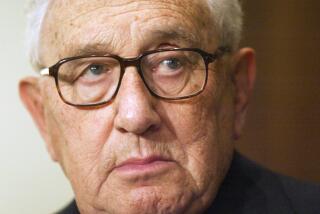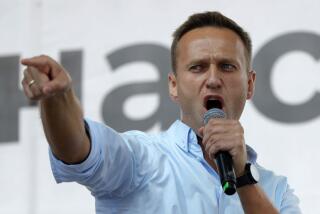History’s Most Efficient Mass Murderer : THE GREAT TERROR A Reassessment <i> by Robert H. Conquest (Oxford University Press: $24.95; 560 pp.; 0-19-505580-2) </i>
- Share via
“You think twenty million? I think more.” So answered a young Soviet intellectual a few weeks ago to a passing comment about the number of Joseph Stalin’s victims.
The terror of the 1930s, directed against peasants, intellectuals, Communists who had opposed Stalin in the 1920s, and Stalin’s own army and bureaucracy, is a nightmarish memory that still transfixes Soviet citizens in all walks of life. There is scarcely anyone in the Soviet Union today who did not have a relative, or a friend’s relative, either perish or emerge half-dead from the holocaust perpetrated on his own people by the dictator whom one eminent Soviet historian recently described to me as “even worse than Hitler.”
Now, finally, the peoples of the Soviet Union have won the freedom to work their way through their horrible collective memories, made worse because these experiences could not be publicly exorcised for decades even after the terror itself had largely ended with the tyrant’s death in 1953. In this task, the Soviets can now even accept the help of outsiders who have been able to study the terror from afar with a good degree of accuracy. Thus it is eminently fitting that the work of Robert Conquest, the West’s No. 1 expert on Stalin’s purges, is now being published in Russian translation in Moscow.
English-born and educated, Robert Conquest was already a world-class authority in Sovietology when he came to this country to become curator of the famous Hoover Library of War and Revolution at Stanford University, one of the world’s major repositories of documentation on 20th-Century Russia.
Availing himself of the new historical data from Soviet sources freed up by glasnost , Conquest has now updated and fleshed out his classic study of the purges. The extraordinary thing is how closely the new information fits with the conclusions he had to work out 20 years ago through scraps of evidence and logical conjecture. As Conquest points out in his preface, he did not have to change any substantive conclusions in the new edition of “The Great Terror.” This is not unusual: By and large, the whole body of Western Sovietology, long vilified by the Soviets as “bourgeois falsification,” is being validated by the archives and actually embraced by the Soviets as the best guide they have to the honest understanding of their own past.
“The Great Terror” is a meticulous chronological account of the purges that Stalin carried out in the Soviet Union between 1935 and 1939, after his brutal collectivization campaign of 1929-1932 and the man-made famine of 1932-33 that Conquest chronicled in “The Harvest of Sorrow” (Oxford, 1986).
As Conquest shows us, the terror was neither a momentary explosion nor an unceasing internal war. Instead, it came on as a wave of successive campaigns directed by Stalin at his supposed enemies, rising in intensity from the initial pretext, the assassination in December, 1934, of Sergei Kirov (the Leningrad Party chief and putative liberal alternative to Stalin), to the orgy of arrest and liquidation in 1937 and 1938.
The Kirov affair initiated the more familiar side of the purges, the incredible series of trials and confessions by Stalin’s Communist adversaries through which Conquest takes us in the first half of “The Great Terror.” Gregory Zinoviev, Lev Kamenev and the former Leningrad Communist leadership were tried and executed in the first of the famous Moscow Trials in 1936, where all the accused confessed to preposterous charges of plotting to kill Stalin and restore capitalism.
Similar trials of Trotsky’s followers and of Nikolai Bukharin and his “Right Opposition” group followed in quick succession in 1937 and 1938, with similar public confessions by the accused, now charged with plotting with the Germans and Japanese to partition the Soviet Union, with the medical murder of writer Maxim Gorky and others, and even retrospectively with a plot on Lenin’s life immediately after the Revolution.
The problem of the confessions has long defied explanation, though every kind of theory has been advanced. Conquest stresses the Old Bolsheviks’ dedication to “the party” as the source of “all morality and all truth,” combined with the NKVD’s refined techniques of relentless interrogation and torture, plus the simple matter of threats to families and hopes for clemency. However, it is not widely realized that quite a few of the old oppositionists, especially Trotskyists, resisted all this and were simply dispatched without the formality of a trial. What remains the greatest puzzle connected with the trials, as Conquest points out, was the widespread acceptance of their authenticity in the outside world, among all political persuasions, not just Communists.
Part Two of “The Great Terror” takes us methodically through the lesser-known but much more extensive and even more baffling side of the purges, the Yezhovshchina or “Yezhov business,” as it is commonly called after Nikolai Yezhov, Stalin’s commissar of the NKVD from 1936 to 1938. Largely conducted in secret, this campaign struck everywhere in Soviet society, not just against known enemies of Stalin but also against the entire generation of leadership who had worked with him up to that point.
Through the cycle of arrest, torture, confession and implication of ever-widening circles of people in imaginary plots, Stalin and Yezhov mowed down the officer corps of the Red Army, the cultural elite, the managers of the new industrial establishment, leaders of the national minorities and, most surprising of all, the bureaucratic apparatus of the Communist Party itself, not to mention most of the foreign Communists who had sought refuge from fascism in the Soviet Union. The final installment of the terror was the liquidation of the purgers themselves, including Yezhov and most of the leadership of the NKVD.
My own study of the age composition of the postwar Soviet elite shows that, apart from a minuscule group of cronies, Stalin literally purged everybody who was somebody in the U.S.S.R. over the age of 35 (or for the military, over 40). Other than members of Stalin’s Politburo and a few other lackeys, no one born before 1902 was left to staff the bureaucracy. This fact in turn accounts for the longevity in office of the Brezhnev generation who were promoted to fill the shoes of the purge victims; they did not fall by the wayside until the 1970s and 1980s, when at last the path was opened for the Gorbachev generation of reformers.
The exhaustion of Stalin’s frantic search for “enemies of the people” did not mean the end of arbitrary arrest and imprisonment. The gulag and prison population of about 8 million at the end of 1938, by Conquest’s estimate, was periodically replenished thereafter by deportations from the Western territories seized in 1939-1940 (including the Baltic states); by Axis prisoners of war; then by Soviet POWs and forced laborers accused of treason after they were repatriated at the end of the war; by certain categories of people purged after the war (Jewish intellectuals, Communists who backed the wrong horse during the infighting among Stalin’s lieutenants); by common criminals (including the perpetrators of “economic crimes” that would be legal business in most countries), and by all those (like Alexander Solzhenitsyn) who gave the authorities any reason to doubt their loyalty. Conquest gives the figure of 12 million still alive in the camps in 1952, of whom about 8 million were amnestied after Stalin’s death.
Naturally, today’s readers, like those of a generation ago, will want to know why and how all these crimes could possibly have happened. Explanation of this order is perhaps the less definitive side of Conquest’s work.
Following the facts closely, he shows Stalin to be what George Kennan called “a man of incredible criminality effectively without limits.” But this picture does not fully explain how Stalin could amass the power that enabled him to give free rein to his murderous instincts. Was he, as Solzhenitsyn--and even some Soviets nowadays--holds, simply the logical sequel to Lenin and the Communist Revolution, or was he a demonic usurper who crushed all that was good in the revolutionary experiment, as a majority of Soviet intellectuals still seem to believe?
This is an old issue among Western observers, and it is not likely to be resolved soon. However, if one simply adds up the victims, Stalin killed more Communists than all of this century’s right-wing dictators put together. If his claims of Marxist-Leninist ideological virtue did not still confuse us, we would recognize him as the greatest counterrevolutionary despot of all time.
More to Read
Sign up for our Book Club newsletter
Get the latest news, events and more from the Los Angeles Times Book Club, and help us get L.A. reading and talking.
You may occasionally receive promotional content from the Los Angeles Times.







